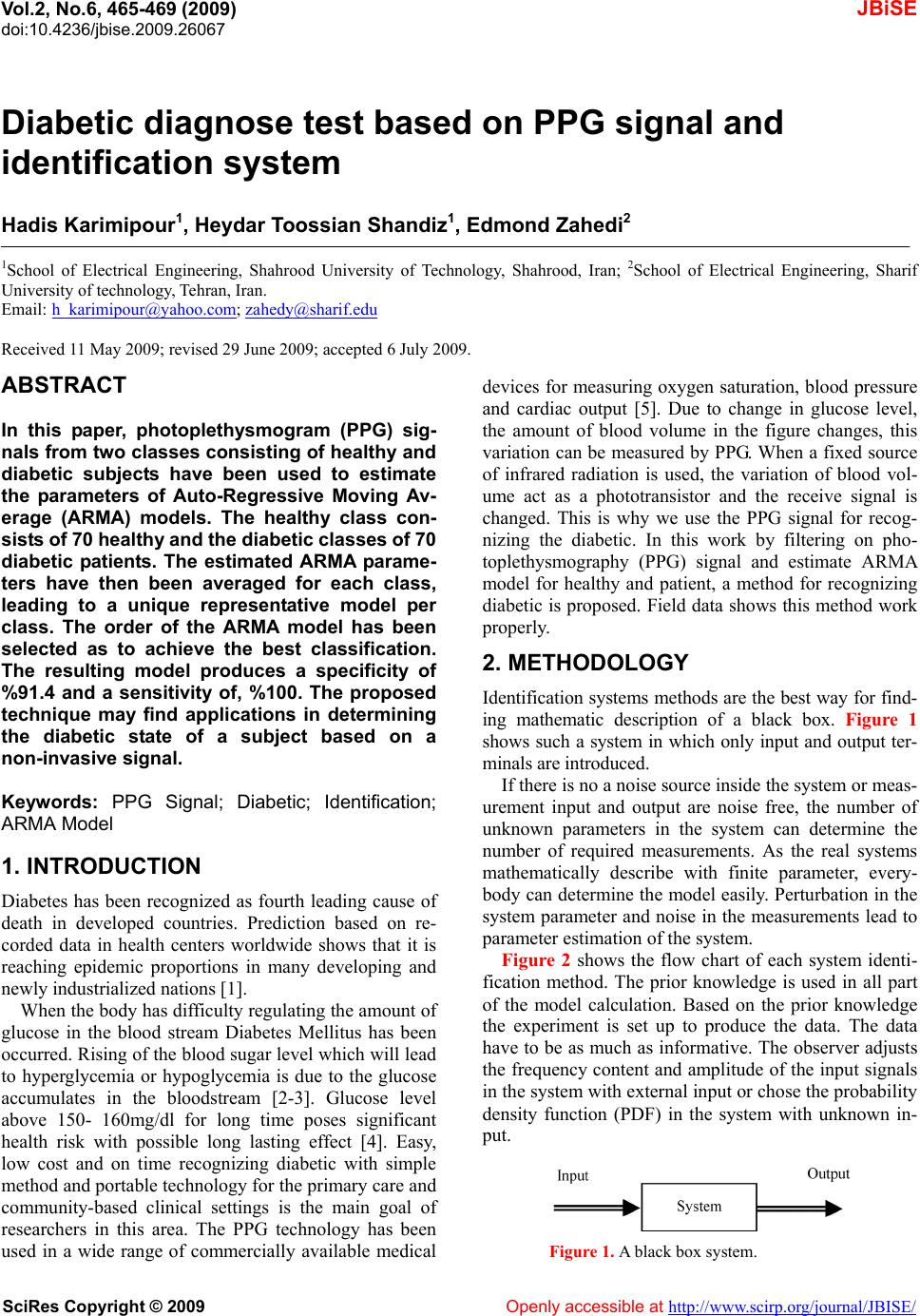
Vol.2, No.6, 465-469 (2009)
doi:10.4236/jbise.2009.26067
SciRes Copyright © 2009 Openly accessible at http://www.scirp.org/journal/JBISE/
JBiSE
Diabetic diagnose test based on PPG signal and
identification system
Hadis Karimipour1, Heydar Toossian Shandiz1, Edmond Zahedi2
1School of Electrical Engineering, Shahrood University of Technology, Shahrood, Iran; 2School of Electrical Engineering, Sharif
University of technology, Tehran, Iran.
Email: h_karimipour@yahoo.com; zahedy@sharif.edu
Received 11 May 2009; revised 29 June 2009; accepted 6 July 2009.
ABSTRACT
In this paper, photoplethysmogram (PPG) sig-
nals from two classes consisting of healthy and
diabetic subjects have been used to estimate
the parameters of Auto-Regressive Moving Av-
erage (ARMA) models. The healthy class con-
sist s of 70 healthy and the diabetic classes of 70
diabetic patients. The estimated ARMA parame-
ters have then been averaged for each class,
leading to a unique representative model per
class. The order of the ARMA model has been
selected as to achieve the best classification.
The resulting model produces a specificity of
%91.4 and a sensitivity of, %100. The proposed
technique may find applications in determining
the diabetic state of a subject based on a
non-invasive signal.
Keywords: PPG Signal; Diabetic; Identification;
ARMA Model
1. INTRODUCTION
Diabetes has been recognized as fourth leading cause of
death in developed countries. Prediction based on re-
corded data in health centers worldwide shows that it is
reaching epidemic proportions in many developing and
newly industrialized nations [1].
When the body has difficulty regulating the amount of
glucose in the blood stream Diabetes Mellitus has been
occurred. Rising of the blood sugar lev el which will lead
to hyperglycemia or hypoglycemia is due to the glucose
accumulates in the bloodstream [2-3]. Glucose level
above 150- 160mg/dl for long time poses significant
health risk with possible long lasting effect [4]. Easy,
low cost and on time recognizing diabetic with simple
method and portable technology for the primary care and
community-based clinical settings is the main goal of
researchers in this area. The PPG technology has been
used in a wide range of commercially available medical
devices for measuring oxygen saturation, blood pressure
and cardiac output [5]. Due to change in glucose level,
the amount of blood volume in the figure changes, this
variation can be measured by PPG. When a fixed source
of infrared radiation is used, the variation of blood vol-
ume act as a phototransistor and the receive signal is
changed. This is why we use the PPG signal for recog-
nizing the diabetic. In this work by filtering on pho-
toplethysmography (PPG) signal and estimate ARMA
model for healthy and patient, a method for recognizing
diabetic is proposed. Field data shows this method work
properly.
2. METHODOLOGY
Identification systems methods are the best way for find-
ing mathematic description of a black box. Figure 1
shows such a system in which only input and output ter-
minals are introduced.
If there is no a noise sourc e insi d e th e s ys te m or me as -
urement input and output are noise free, the number of
unknown parameters in the system can determine the
number of required measurements. As the real systems
mathematically describe with finite parameter, every-
body can determine the mod el easily. Perturbation in the
system parameter and noise in the measurements lead to
parameter estimation of the system.
Figure 2 shows the flow chart of each system identi-
fication method. The prior knowledge is used in all part
of the model calculation. Based on the prior knowledge
the experiment is set up to produce the data. The data
have to be as much as informative. The observer adjusts
the frequency content and amplitude of the input signals
in the system with external input or chose the probab ility
density function (PDF) in the system with unknown in-
put.
Figure 1. A black box system.